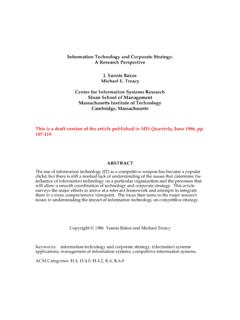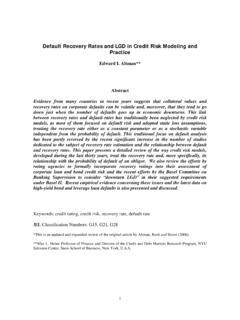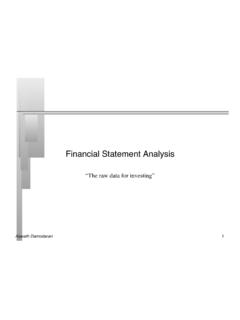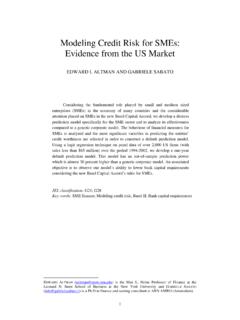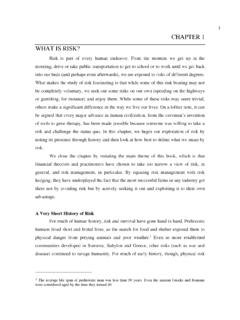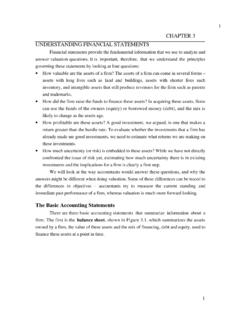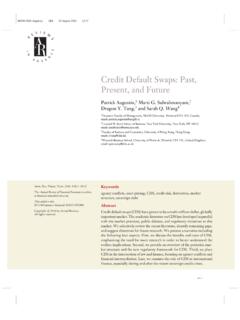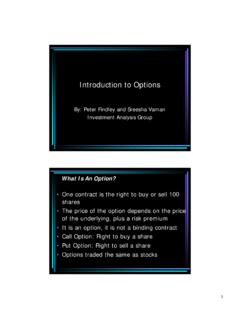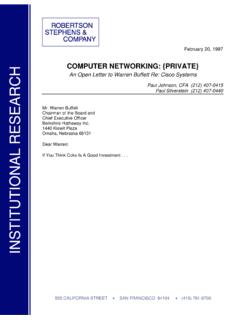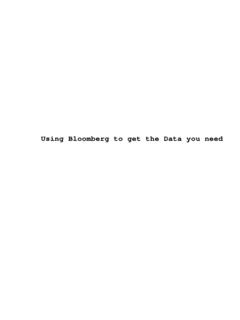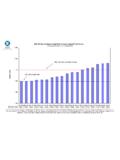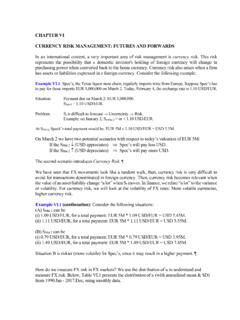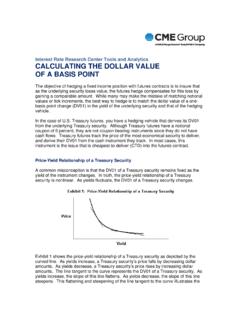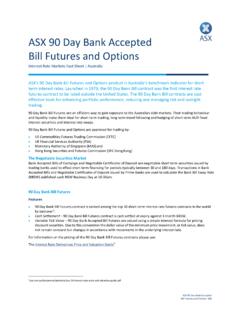Transcription of Futures, Forward and Option Contracts How a Futures ...
1 1 CHAPTER 34 VALUING Futures AND Forward CONTRACTSA Futures contract is a contract between two parties to exchange assets or servicesat a specified time in the future at a price agreed upon at the time of the contract. In mostconventionally traded Futures Contracts , one party agrees to deliver a commodity orsecurity at some time in the future , in return for an agreement from the other party to payan agreed upon price on delivery. The former is the seller of the Futures contract, whilethe latter is the chapter explores the pricing of Futures Contracts on a number of differentassets - perishable commodities, storable commodities and financial assets - by setting upthe basic arbitrage relationship between the Futures contract and the underlying asset. Italso examines the effects of transactions costs and trading restrictions on this relationshipand on Futures prices.
2 Finally, the chapter reviews some of the evidence on the pricing offutures , Forward and Option ContractsFutures, Forward and Option Contracts are all viewed as derivative contractsbecause they derive their value from an underlying asset. There are however some keydifferences in the workings of these a Futures Contract worksThere are two parties to every Futures contract - the seller of the contract, whoagrees to deliver the asset at the specified time in the future , and the buyer of the contract,who agrees to pay a fixed price and take delivery of the : Cash Flows on Futures ContractsSpot Price onUnderlying AssetBuyer'sPayoffsSeller'sPayoffsFuture sPriceWhile a Futures contract may be used by a buyer or seller to hedge other positions in thesame asset, price changes in the asset after the Futures contract agreement is made providegains to one party at the expense of the other.
3 If the price of the underlying assetincreases after the agreement is made, the buyer gains at the expense of the seller. If theprice of the asset drops, the seller gains at the expense of the versus Forward ContractsWhile Futures and Forward Contracts are similar in terms of their final results, aforward contract does not require that the parties to the contract settle up until theexpiration of the contract. Settling up usually involves the loser ( , the party thatguessed wrong on the direction of the price) paying the winner the difference between thecontract price and the actual price. In a Futures contract, the differences is settled everyperiod, with the winner's account being credited with the difference, while the loser'saccount is reduced. This process is called marking to the market. While the net settlementis the same under the two approaches, the timing of the settlements is different and can3lead to different prices for the two types of Contracts .
4 The difference is illustrated in thefollowing example, using a Futures contract in : Futures versus Forward Contracts - Gold Futures ContractAssume that the spot price of gold is $400, and that a three-period futurescontract on gold has a price of $415. The following table summarizes the cash flow to thebuyer and seller of this contract on a Futures and Forward contract over the next 3 timeperiods, as the price of the gold Futures contract PeriodGold FuturesContractBuyer's CF:ForwardSeller's CF:ForwardBuyer's CF:FuturesSeller's CF:Futures1$420$0$0$5-$52$430$0$0$10-$10 3$425$10-$10-$5$5 Net$10-$10$10-$10 The net cash flow from the seller to the buyer is $10 in both cases, but the timing of thecash flows is different. On the Forward contract, the settlement occurs at maturity. On thefutures contract, the profits or losses are recorded each and Forward Contracts versus Option ContractsWhile the difference between a Futures and a Forward contract may be subtle, thedifference between these Contracts and Option Contracts is much greater.
5 In an optionscontract, the buyer is not obligated to fulfill his side of the bargain, which is to buy theasset at the agreed upon strike price in the case of a call Option and to sell the asset at thestrike price in the case of a put Option . Consequently the buyer of an Option will exercisethe Option only if it is in his or her best interests to do so, , if the asset price exceedsthe strike price in a call Option and vice versa in a put Option . The buyer of the Option , ofcourse, pays for this privilege up front. In a Futures contract, both the buyer and the sellerare obligated to fulfill their sides of the agreement. Consequently, the buyer does not gainan advantage over the seller and should not have to pay an up front price for the futurescontract itself. Figure summarizes the differences in payoffs on the two types ofcontracts in a payoff : Buying a Futures Contract versus Buying a Call Option4 Spot Price onUnderlying AssetFuturesPriceFutures ContractCall OptionTraded Futures Contracts - Institutional DetailsA Futures contract is an agreement between two parties.
6 In a traded futurescontract, an exchange acts as an intermediary and guarantor, and also standardizes andregulates how the contract is created and of Contract -----------> Futures Exchange<---------- Seller of ContractIn this section, we will examine some of the institutional features of traded StandardizationTraded Futures Contracts are standardized to ensure that Contracts can be easilytraded and priced. The standardization occurs at a number of levels.(a) Asset Quality and Description: The type of asset that can be covered by thecontract is clearly defined. For instance, a lumber Futures contract traded on theChicago Mercantile Exchange allows for the delivery of 110,000 board feet oflumber per contract. A treasury bond Futures contract traded on the Chicago5 Board of Trade requires the delivery of bonds with a face value of $100,000 with amaturity of greater than 15 years1.
7 (b) Asset Quantity: Each traded Futures contract on an asset provides for thedelivery of a specified quantity of the asset. For instance, a gold Futures contracttraded on the Chicago Board of trade requires the delivery of 100 ounces of gold atthe Contracts purpose of the standardization is to ensure that the Futures Contracts on an asset areperfect substitutes for each other. This allows for liquidity and also allows parties to afutures contract to get out of positions Price LimitsFutures exchanges generally impose price movement limits on most futurescontracts. For instance, the daily price movement limit on orange juice Futures contract onthe New York Board of Trade is 5 cents per pound or $750 per contract (which covers15,000 pounds). If the price of the contract drops or increases by the amount of the pricelimit, trading is generally suspended for the day, though the exchange reserves thediscretion to reopen trading in the contract later in the day.
8 The rationale for introducingprice limits is to prevent panic buying and selling on an asset, based upon faultyinformation or rumors, and to prevent overreaction to real information. By allowinginvestors more time to react to extreme information, it is argued, the price reaction will bemore rational and Marking to MarketOne of the unique features of Futures Contracts is that the positions of bothbuyers and sellers of the Contracts are adjusted every day for the change in the marketprice that day. In other words, the profits or losses associated with price movements arecredited or debited from an investor s account even if he or she does not trade. Thisprocess is called marking to Margin Requirements for Trading 1 The reason the exchange allows equivalents is to prevent investors from buying a significant portion of6In a Futures agreement, there is no payment made by the buyer to the seller, nordoes the seller have to show proof of physical ownership of the asset at the time of theagreement.
9 In order to ensure, however, that the parties to the Futures contract fulfill theirsides of the agreement, they are required to deposit funds in a margin account. Theamount that has to be deposited at the time of the contract is called the initial margin. Asprices move subsequently, the Contracts are marked to market, and the profits or lossesare posted to the investor s account. The investor is allowed to withdraw any funds inthe margin account in excess of the initial margin. Table summarizes price limits andcontract specifications for many traded Futures Contracts as of June : Futures Contracts : Description, Price Limits and MarginsContractExchangeSpecificationsTic k ValueInitialMargin/ContractDailyLimit/un itSoftsCoffeeNYBOT37,500 lbs$ $2,450noneSugarNYBOT112,000 lbs$ $840noneCocoaNYBOT10 metrictons$10/1 $980noneCottonNYBOT50,000 lbs$5 $1,0003 Orange JuiceNYBOT15,000 lbs$ $7005 MetalsGoldNYMEX100 troy ozs$10/10 $1,350$75 Kilo GoldCBOT1 gross kgm$ $473$50 SilverNYMEX5000 troyozs$25 $1,350$ SilverCBOT5000 troyozs$5 $270$1 CopperNYMEX25,000 lbs$ $4,050$ troy ozs$5/10 $2,160$25 PalladiumNYMEX100 troy ozs$5/5 $67,500noneEnergyCrudeNYMEX1,000 barrels$10/1 $3,375$ ,000gallons$ $3,37520 firstHeating OilNYMEX42,000gallons$ $3,37520 firstNatural GasNYMEX10,000 mm$10 $4.
10 725$1 the specified treasury bonds and cornering the CattleCME40,000 lbs$10 $ Feeder CattleCME50,000 lbs$ $ Lean HogsCME40,000 lbs$10 $9992 Pork BelliesCME40,000 lbs$10 $1,6203 LumberCME110,000 ft$11/10 $1,013$10 CurrenciesEuroCurrencyCME125,000 Euros$ $2,349400 ticksSwiss FrancCME125,000 Sfr$ $1,755400 ticksJapanese YenCME12,500,000 Yen$ $2,835400 ticksBritish PoundCME62,500 Bp$ $1,418800 ticksCanadian DlrCME100,000 C$$10 $608400 ticksAustralianDlrCME100,000 A$$10 $1,215400 ticksMexicanPesoCME500,000pesos$ $2,5002000ticksDollar IndexNYBOT$1,000 timesdollar index$10 $1,9952 ptsInterest RateT-BondCBOT$100,000face value$ $2,363 NoneT-Note (10)CBOT$100,000face value$ $1,620 NoneT-Note (5)CBOT$100,000face value$ $1,080 NoneMuni BondCBOT$1,000 timesthe closingvalue of TheBondBuyer 40 Index$ $1,350 NoneMidam BondMIDAM$50,000 facevalue$ $8783ptsT-BillsCME$1,000,000$25 $540 NoneEurodollarsCME$1,000,000$25 $810 NoneIndicesS&P 500 CME$250 timesS&P 500 Index$25 Pts.
